Characteristics of Changes in Land Use Intensity in Xinjiang Under Different Future Climate Change Scenarios
Abstract
1. Introduction
- (1)
- Explore the spatiotemporal heterogeneity of Xinjiang under three future SSP scenarios (SSP126, SSP245, SSP585) using a multi-source data and multi-temporal framework;
- (2)
- Characterize the evolution of land use intensity under future climate change scenarios;
- (3)
- Identify the driving mechanisms of land use intensity and propose sustainable development strategies for Xinjiang.
2. Materials and Methods
2.1. Study Area
2.2. Data Sources and Processing
2.3. Research Methodology
2.3.1. LULC Modeling Under Different Future Climate Scenarios
2.3.2. Intensity Analysis Method
2.3.3. Analysis of Factors Influencing Land Use Intensity
| Type | Bare Land Level | Forest, Grassland, and Water Level | Agricultural Land Level | Constructed Land Level |
|---|---|---|---|---|
| Land Use Categories | Bare Land | Forest, Grassland, and Water | Cropland | Constructed land |
| Grading Index | 1 | 2 | 3 | 4 |
3. Analysis with Results
3.1. LULC Change Analysis
3.2. Land Use Intensity Map and Intensity Analysis
3.3. Spatial Heterogeneity Analysis of Driving Force
4. Discussion
4.1. Impact of LULC Changes Under Different Climate Scenarios
4.2. Characteristics of Land Use Intensity Maps Under Different Climate Scenarios
4.3. Impact of Land Use Intensity Under Different Climate Scenarios
4.4. Influence of Driving Force on Land Use Intensity
4.5. Outlook and Limitations
5. Conclusions
Author Contributions
Funding
Institutional Review Board Statement
Informed Consent Statement
Data Availability Statement
Conflicts of Interest
References
- Dullinger, I.; Essl, F.; Moser, D.; Erb, K.; Haberl, H.; Dullinger, S. Biodiversity models need to represent land-use intensity more comprehensively. Glob. Ecol. Biogeogr. 2021, 30, 924–932. [Google Scholar] [CrossRef]
- Han, B.; Jin, X.; Sun, R.; Li, H.; Liang, X.; Zhou, Y. Understanding land-use sustainability with a systematical framework: An evaluation case of China. Land Use Policy 2023, 132, 106767. [Google Scholar] [CrossRef]
- Rao, Y.; Zhang, J.; Wang, K.; Jepsen, M.R. Understanding land use volatility and agglomeration in northern Southeast Asia. J. Environ. Manag. 2021, 278, 111536. [Google Scholar] [CrossRef] [PubMed]
- Shi, M.; Wu, H.; Jiang, P.; Zheng, K.; Liu, Z.; Dong, T.; He, P.; Fan, X. Food-water-land-ecosystem nexus in typical Chinese dryland under different future scenarios. Sci. Total Environ. 2023, 880, 163183. [Google Scholar] [CrossRef]
- Liang, X.; Guan, Q.F.; Clarke, K.C.; Liu, S.S.; Wang, B.Y.; Yao, Y. Understanding the drivers of sustainable land expansion using a patch-generating land use simulation (PLUS) model: A case study in Wuhan, China. Comput. Environ. Urban Syst. 2021, 85, 101569. [Google Scholar] [CrossRef]
- Shi, M.; Wu, H.; Jia, H.; Zhu, L.; Dong, T.; He, P.; Yang, Q. Temporal and spatial evolution and prediction of carbon stocks in Yili Valley based on MCE-CA-Markov and InVEST models. J. Agric. Resour. Environ. 2021, 38, 1010–1019. [Google Scholar]
- Akin, A.; Erdogan, N.; Berberoglu, S.; Cilek, A.; Erdogan, A.; Donmez, C.; Satir, O. Evaluating the efficiency of future crop pattern modelling using the CLUE-S approach in an agricultural plain. Ecol. Inform. 2022, 71, 101806. [Google Scholar] [CrossRef]
- Wang, Z.; Guo, M.; Zhang, D.; Chen, R.; Xi, C.; Yang, H. Coupling the Calibrated GlobalLand30 Data and Modified PLUS Model for Multi-Scenario Land Use Simulation and Landscape Ecological Risk Assessment. Remote Sens. 2023, 15, 5186. [Google Scholar] [CrossRef]
- Chaudhuri, G.; Clarke, K. The SLEUTH land use change model: A review. Environ. Resour. Res. 2013, 1, 88–105. [Google Scholar]
- O’Neill, B.C.; Tebaldi, C.; Van Vuuren, D.P.; Eyring, V.; Friedlingstein, P.; Hurtt, G.; Knutti, R.; Kriegler, E.; Lamarque, J.-F.; Lowe, J. The scenario model intercomparison project (ScenarioMIP) for CMIP6. Geosci. Model Dev. 2016, 9, 3461–3482. [Google Scholar] [CrossRef]
- Xu, Z. Towards carbon neutrality in China: A systematic identification of China’s sustainable land-use pathways across multiple scales. Sustain. Prod. Consum. 2024, 44, 167–178. [Google Scholar] [CrossRef]
- Liu, Y.; Chen, X.; Bai, Y.; Zeng, J. Evaluation of 22 CMIP6 model-derived global soil moisture products of different shared socioeconomic pathways. J. Hydrol. 2024, 636, 131241. [Google Scholar] [CrossRef]
- Chen, Y.; Zhu, M.; Zhou, Q.; Qiao, Y. Research on Spatiotemporal Differentiation and Influence Mechanism of Urban Resilience in China Based on MGWR Model. Int. J. Environ. Res. Public Health 2021, 18, 1056. [Google Scholar] [CrossRef] [PubMed]
- Huang, X.; Huang, X.; Liu, M.; Wang, B.; Zhao, Y. Spatial-temporal Dynamics and Driving Forces of Land Development Intensity in the Western China from 2000 to 2015. Chin. Geogr. Sci. 2020, 30, 16–29. [Google Scholar] [CrossRef]
- Ma, H. Spatiotemporal analysis of land use changes and their trade-offs on the northern slope of the Tianshan Mountains, China. Front. Ecol. Evol. 2022, 10, 1016774. [Google Scholar] [CrossRef]
- Tong, S.; Bao, G.; Rong, A.; Huang, X.; Bao, Y.; Bao, Y. Comparison of the Spatiotemporal Dynamics of Land Use Changes in Four Municipalities of China Based on Intensity Analysis. Sustainability 2020, 12, 3687. [Google Scholar] [CrossRef]
- Martin, Y.; Van Dyck, H.; Dendoncker, N.; Titeux, N. Testing instead of assuming the importance of land use change scenarios to model species distributions under climate change. Glob. Ecol. Biogeogr. 2013, 22, 1204–1216. [Google Scholar] [CrossRef]
- Zhu, G.; Xu, X.; Ma, Z.; Xu, L.; Porter, J.H. Spatial Dynamics and Zoning of Coastal Land-Use Change along Bohai Bay, China, during 1979–2008. J. Coast. Res. 2012, 28, 1186–1196. [Google Scholar]
- Li, S.; Gong, J.; Yang, J.; Chen, G.; Zhang, Z.; Zhang, M. Characteristics of Land Use/Land Cover Change Patterns in the Lanxi Urban Agglomeration—Based on the Intensity Analysis Framework. Resour. Sci. 2023, 45, 480–493. [Google Scholar]
- Li, T.; Jiang, H.; Jing, P.; Yu, Y.; Zhang, M.; Sang, H. A Data-Driven Study on the Impact of Land Use on Traffic Congestion Based on GWR Model. In Proceedings of the 20th COTA International Conference of Transportation Professionals (CICTP)—Advanced Transportation, Enhanced Connection, Xi’an, China, 14–16 August 2020; pp. 3051–3060. [Google Scholar]
- Zhu, H.; Ou, X.; Yang, Z.; Yang, Y.; Ren, H.; Tang, L. Spatiotemporal Dynamics and Driving Forces of Land Urbanization in the Yangtze River Delta Urban Agglomeration. Land 2022, 11, 1365. [Google Scholar] [CrossRef]
- Zhou, K.; Wang, X.; Wang, Z.; Hu, Y. Systematicity and Stability Analysis of Land Use Change-Taking Jinan, China, as an Example. Land 2022, 11, 1045. [Google Scholar] [CrossRef]
- Dandridge, C.; Stanley, T.; Kirschbaum, D.; Amatya, P.; Lakshmi, V. The influence of land use and land cover change on landslide susceptibility in the Lower Mekong River Basin. Nat. Hazards 2023, 115, 1499–1523. [Google Scholar] [CrossRef]
- Yang, D.; Zhang, P.; Jiang, L.; Zhang, Y.; Liu, Z.; Rong, T. Spatial change and scale dependence of built-up land expansion and landscape pattern evolution-Case study of affected area of the lower Yellow River. Ecol. Indic. 2022, 141, 109123. [Google Scholar] [CrossRef]
- Zhang, J.; Zhang, P.; Gu, X.; Deng, M.; Lai, X.; Long, A.; Deng, X. Analysis of Spatio-Temporal Pattern Changes and Driving Forces of Xinjiang Plain Oases Based on Geodetector. Land 2023, 12, 1508. [Google Scholar] [CrossRef]
- Zhang, L.; Lei, J.; Wang, C.; Wang, F.; Geng, Z.; Zhou, X. Spatio-temporal variations and influencing factors of energy-related carbon emissions for Xinjiang cities in China based on time-series nighttime light data. J. Geogr. Sci. 2022, 32, 1886–1910. [Google Scholar] [CrossRef]
- Zhang, F.; Wang, Y.; Jim, C.Y.; Chan, N.W.; Tan, M.L.; Kung, H.-T.; Shi, J.; Li, X.; He, X. Analysis of Urban Expansion and Human-Land Coordination of Oasis Town Groups in the Core Area of Silk Road Economic Belt, China. Land 2023, 12, 224. [Google Scholar] [CrossRef]
- Cai, T.; Luo, X.; Fan, L.; Han, J.; Zhang, X. The Impact of Cropland Use Changes on Terrestrial Ecosystem Services Value in Newly Added Cropland Hotspots in China during 2000–2020. Land 2022, 11, 2294. [Google Scholar] [CrossRef]
- Zheng, L.; Xia, Z.; Xu, J.; Chen, Y.; Yang, H.; Li, D. Exploring annual lake dynamics in Xinjiang (China): Spatiotemporal features and driving climate factors from 2000 to 2019. Clim. Change 2021, 166, 36. [Google Scholar] [CrossRef]
- Chen, W.; Chi, G.; Li, J. Ecosystem Services and Their Driving Forces in the Middle Reaches of the Yangtze River Urban Agglomerations, China. Int. J. Environ. Res. Public Health 2020, 17, 3717. [Google Scholar] [CrossRef]
- Chen, Y.; Guo, F.; Wang, J.; Cai, W.; Wang, C.; Wang, K. Provincial and gridded population projection for China under shared socioeconomic pathways from 2010 to 2100. Sci. Data 2020, 7, 83. [Google Scholar] [CrossRef]
- Hurtt, G.C.; Chini, L.; Sahajpal, R.; Frolking, S.; Bodirsky, B.L.; Calvin, K.; Doelman, J.C.; Fisk, J.; Fujimori, S.; Goldewijk, K.K.; et al. Harmonization of global land use change and management for the period 850-2100 (LUH2) for CMIP6. Geosci. Model Dev. 2020, 13, 5425–5464. [Google Scholar] [CrossRef]
- Zomer, R.J.; Xu, J.; Trabucco, A. Version 3 of the Global Aridity Index and Potential Evapotranspiration Database. Sci. Data 2022, 9, 409. [Google Scholar] [CrossRef]
- Shi, M.; Wu, H.; Jiang, P.; Shi, W.; Zhang, M.; Zhang, L.; Zhang, H.; Fan, X.; Liu, Z.; Zheng, K.; et al. Cropland Expansion Mitigates the Supply and Demand Deficit for Carbon Sequestration Service under Different Scenarios in the Future—The Case of Xinjiang. Agriculture 2022, 12, 1182. [Google Scholar] [CrossRef]
- Popp, A.; Calvin, K.; Fujimori, S.; Havlik, P.; Humpenoeder, F.; Stehfest, E.; Bodirsky, B.L.; Dietrich, J.P.; Doelmann, J.C.; Gusti, M.; et al. Land-use futures in the shared socio-economic pathways. Glob. Environ. Change—Hum. Policy Dimens. 2017, 42, 331–345. [Google Scholar] [CrossRef]
- Qiu, Y.; Hu, Q.; Zhang, C. WRF simulation and downscaling of local climate in Central Asia. Int. J. Climatol. 2017, 37, 513–528. [Google Scholar] [CrossRef]
- Bai, R.; Sun, J.; Yu, E.; Yu, S. Performance of the Weather Research and Forecasting model in simulating climate over northern Asia. Int. J. Climatol. 2022, 42, 10285–10307. [Google Scholar] [CrossRef]
- Xu, Z.; Han, Y.; Tam, C.-Y.; Yang, Z.-L.; Fu, C. Bias-corrected CMIP6 global dataset for dynamical downscaling of the historical and future climate (1979–2100). Sci. Data 2021, 8, 293. [Google Scholar] [CrossRef]
- Li, J.; Chen, X.; Kurban, A.; Van de Voorde, T.; De Maeyer, P.; Zhang, C. Coupled SSPs-RCPs scenarios to project the future dynamic variations of water-soil-carbon-biodiversity services in Central Asia. Ecol. Indic. 2021, 129, 107936. [Google Scholar] [CrossRef]
- Nor, A.N.M.; Corstanje, R.; Harris, J.A.; Brewer, T. Impact of rapid urban expansion on green space structure. Ecol. Indic. 2017, 81, 274–284. [Google Scholar] [CrossRef]
- Sun, Y.; Ge, X.; Liu, J.; Chang, Y.; Liu, G.-J.; Chen, F. Mitigating Spatial Conflict of Land Use for Sustainable Wetlands Landscape in Li-Xia-River Region of Central Jiangsu, China. Sustainability 2021, 13, 11189. [Google Scholar] [CrossRef]
- Ma, Y.; Mamitimin, Y.; Tiemuerbieke, B.; Yimaer, R.; Huang, M.; Chen, H.; Tao, T.; Guo, X. Spatiotemporal Characteristics and Influencing Factors of Urban Heat Island Based on Geographically Weighted Regression Model: A Case Study of Urumqi City. Land 2023, 12, 2012. [Google Scholar] [CrossRef]
- Wang, S.; Liu, J.; Zhang, Z.; Zhou, Q.; Zhao, X. Spatio-temporal Characteristics Analysis of Land Use in China. Acta Geogr. Sin. 2001, 631–639. [Google Scholar] [CrossRef]
- Ma, S.; Shi, M.; Yang, G.; Xu, X.; Yin, J. Spatio-temporal Dynamic Change Analysis of Land Use Based on GIS—Taking the Agricultural Reclamation Area of the Tarim Basin as an Example. Res. Soil Water Conserv. 2013, 20, 177–181. [Google Scholar]
- Zhou, X.; Zhou, Y. Spatio-Temporal Variation and Driving Forces of Land-Use Change from 1980 to 2020 in Loess Plateau of Northern Shaanxi, China. Land 2021, 10, 982. [Google Scholar] [CrossRef]
- Cheng, Y.; Chen, Y. Spatial and Temporal Characteristics of Land Use Changes in the Yellow River Basin from 1990 to 2021 and Future Predictions. Land 2024, 13, 1510. [Google Scholar] [CrossRef]
- Fathy, I.; Ahmed, A.; Abd-Elhamid, H.F. Integrated management of surface water and groundwater to mitigate flood risks and water scarcity in arid and semi-arid regions. J. Flood Risk Manag. 2021, 14, e12720. [Google Scholar] [CrossRef]
- Cai, P.; Hamdi, R.; Luo, G.; He, H.; Zhang, M.; Termonia, P.; De Maeyer, P. Agriculture intensification increases summer precipitation in Tianshan Mountains, China. Atmos. Res. 2019, 227, 140–146. [Google Scholar] [CrossRef]
- Rahman, M.; Islam, M.M.; Kim, H.-J.; Sadiq, S.; Alam, M.; Siddiqua, T.; Mamun, M.A.; Gazi, M.A.H.; Raju, M.R.; Chen, N.; et al. Assessing the Influence of Land Cover and Climate Change Impacts on Runoff Patterns Using CA-ANN Model and CMIP6 Data. ISPRS Int. J. Geo-Inf. 2023, 12, 401. [Google Scholar] [CrossRef]
- Mehriar, M.; Masoumi, H.; Mohino, I. Urban Sprawl, Socioeconomic Features, and Travel Patterns in Middle East Countries: A Case Study in Iran. Sustainability 2020, 12, 9620. [Google Scholar] [CrossRef]
- Luo, G.; Feng, Y.; Zhang, B.; Cheng, W. Sustainable land-use patterns for arid lands: A case study in the northern slope areas of the Tianshan Mountains. J. Geogr. Sci. 2010, 20, 510–524. [Google Scholar] [CrossRef]
- Maimaiti, B.; Chen, S.; Kasimu, A.; Mamat, A.; Aierken, N.; Chen, Q. Coupling and coordination relationships between urban expansion and ecosystem service value in kashgar city. Remote Sens. 2022, 14, 2557. [Google Scholar] [CrossRef]
- Feng, J.; Zhao, L.; Zhang, Y.; Sun, L.; Yu, X.; Yu, Y. Can climate change influence agricultural GTFP in arid and semi-arid regions of Northwest China? J. Arid Land 2020, 12, 837–853. [Google Scholar] [CrossRef]
- Qian, J.; Zhou, Q.; Chen, X.; Sun, B. A model-based analysis of spatio-temporal changes of the urban expansion in arid area of Western China: A case study in North Xinjiang economic zone. Atmosphere 2020, 11, 989. [Google Scholar] [CrossRef]
- Lyu, J.; Yin, S.; Sun, Y.; Wang, K.; Luo, P.; Meng, X. Flood Runoff Simulation under Changing Environment, Based on Multiple Satellite Data in the Jinghe River Basin of the Loess Plateau, China. Remote Sens. 2023, 15, 550. [Google Scholar] [CrossRef]
- Shao, W.; Zhang, Z.; Guan, Q.; Yan, Y.; Zhang, J. Comprehensive assessment of land degradation in the arid and semiarid area based on the optimal land degradation index model. Catena 2024, 234, 107563. [Google Scholar] [CrossRef]
- Du, Y.E.; Liu, B.; He, W.; Zhou, J. Temporal and Spatial Pattern Characteristics of Vegetation in Qaidam Basin and Its Response to Climate Change. In Proceedings of the 5th Annual International Conference on Information System and Artificial Intelligence (ISAI), Zhejiang, China, 22–23 May 2020. [Google Scholar]
- Hanchu, L.; Jie, F.; Baoyin, L.; Li, W.; Qin, Q. Practical exploration of ecological restoration and management of the mountains-rivers-forests-croplands-lakes-grasslands system in the Irtysh River Basin in Altay, Xinjiang. J. Resour. Ecol. 2021, 12, 766–776. [Google Scholar]
- Li, J.; Zhang, Z.; Ma, L.; Gu, Q.; Wang, K.; Xu, Z. Assessment on the impact of arable land protection policies in a rapidly developing region. ISPRS Int. J. Geo-Inf. 2016, 5, 69. [Google Scholar] [CrossRef]
- Wu, J.; Wang, C.; He, X.; Zhou, C.; Wang, H. Nonlinear Effects of Land-Use Conflicts in Xinjiang: Critical Thresholds and Implications for Optimal Zoning. Land 2024, 13, 612. [Google Scholar] [CrossRef]
- Yang, H.; Mu, S.; Li, J. Effects of ecological restoration projects on land use and land cover change and its influences on territorial NPP in Xinjiang, China. Catena 2014, 115, 85–95. [Google Scholar] [CrossRef]
- Zhang, M.; Gao, Y.H.; Zhang, L.; Yang, K.P. Impacts of anthropogenic land use and land cover change on climate extremes based on CMIP6-LUMIP experiments: Part II. Future period. Clim. Dyn. 2024, 62, 3669–3688. [Google Scholar] [CrossRef]
- Cai, T.; Zhang, X.; Xia, F.; Zhang, Z.; Yin, J.; Wu, S. The Process-Mode-Driving Force of Cropland Expansion in Arid Regions of China Based on the Land Use Remote Sensing Monitoring Data. Remote Sens. 2021, 13, 2949. [Google Scholar] [CrossRef]
- Wang, Y.; Shataer, R.; Zhang, Z.; Zhen, H.; Xia, T. Evaluation and Analysis of Influencing Factors of Ecosystem Service Value Change in Xinjiang under Different Land Use Types. Water 2022, 14, 1424. [Google Scholar] [CrossRef]
- Ning, Q.; Ouyang, X.; Liu, S. Spatio-Temporal Evolution and Quality Analysis of Construction Land in Urban Agglomerations in Central China. Front. Ecol. Evol. 2022, 10, 912127. [Google Scholar] [CrossRef]
- Wang, X.; Peng, S.; Wu, J.; Zheng, K.; Wang, S.; Shangguan, Z.; Deng, L. Simulation of the Key Ecosystem Services Changes in China’s Loess Plateau under Various Shared Socioeconomic Pathways Scenarios. Ecosyst. Health Sustain. 2024, 10, 0200. [Google Scholar] [CrossRef]
- Ai, X.; Zheng, X.; Zhang, Y.; Liu, Y.; Ou, X.; Xia, C.; Liu, L. Climate and land use changes impact the trajectories of ecosystem service bundles in an urban agglomeration: Intricate interaction trends and driver identification under SSP-RCP scenarios. Sci. Total Environ. 2024, 944, 173828. [Google Scholar] [CrossRef]
- Li, D.; Wang, X. Land-Use Change and Efficiency in Laos’ Special Economic Zones. Land 2021, 10, 1012. [Google Scholar] [CrossRef]
- Chen, L.; Ma, Y. Current and future characteristics of land use based on intensity analysis and PLUS model: A case study of Foshan city, China. SN Appl. Sci. 2023, 5, 83. [Google Scholar] [CrossRef]
- Tomao, A.; Mattioli, W.; Fanfani, D.; Ferrara, C.; Quaranta, G.; Salvia, R.; Salvati, L. Economic Downturns and Land-Use Change: A Spatial Analysis of Urban Transformations in Rome (Italy) Using a Geographically Weighted Principal Component Analysis. Sustainability 2021, 13, 11293. [Google Scholar] [CrossRef]
- Zhang, S.; Guan, Z.; Liu, Y.; Zheng, F. Land Use/Cover Change and Its Relationship with Regional Development in Xixian New Area, China. Sustainability 2022, 14, 6889. [Google Scholar] [CrossRef]
- Kim, S.; Kim, H.; Kim, K.; Jun, S.-M.; Hwang, S.; Kang, M.-S. Assessing the Hydroclimatic Movement under Future Scenarios Including both Climate and Land Use Changes. Water 2021, 13, 1120. [Google Scholar] [CrossRef]
- Tao, J.; Jiang, Q.; Zhang, X.; Huang, J.; Wang, Y.; Wu, W. From frequency to intensity—A new index for annual large-scale cropping intensity mapping. Comput. Electron. Agric. 2023, 215, 108428. [Google Scholar] [CrossRef]

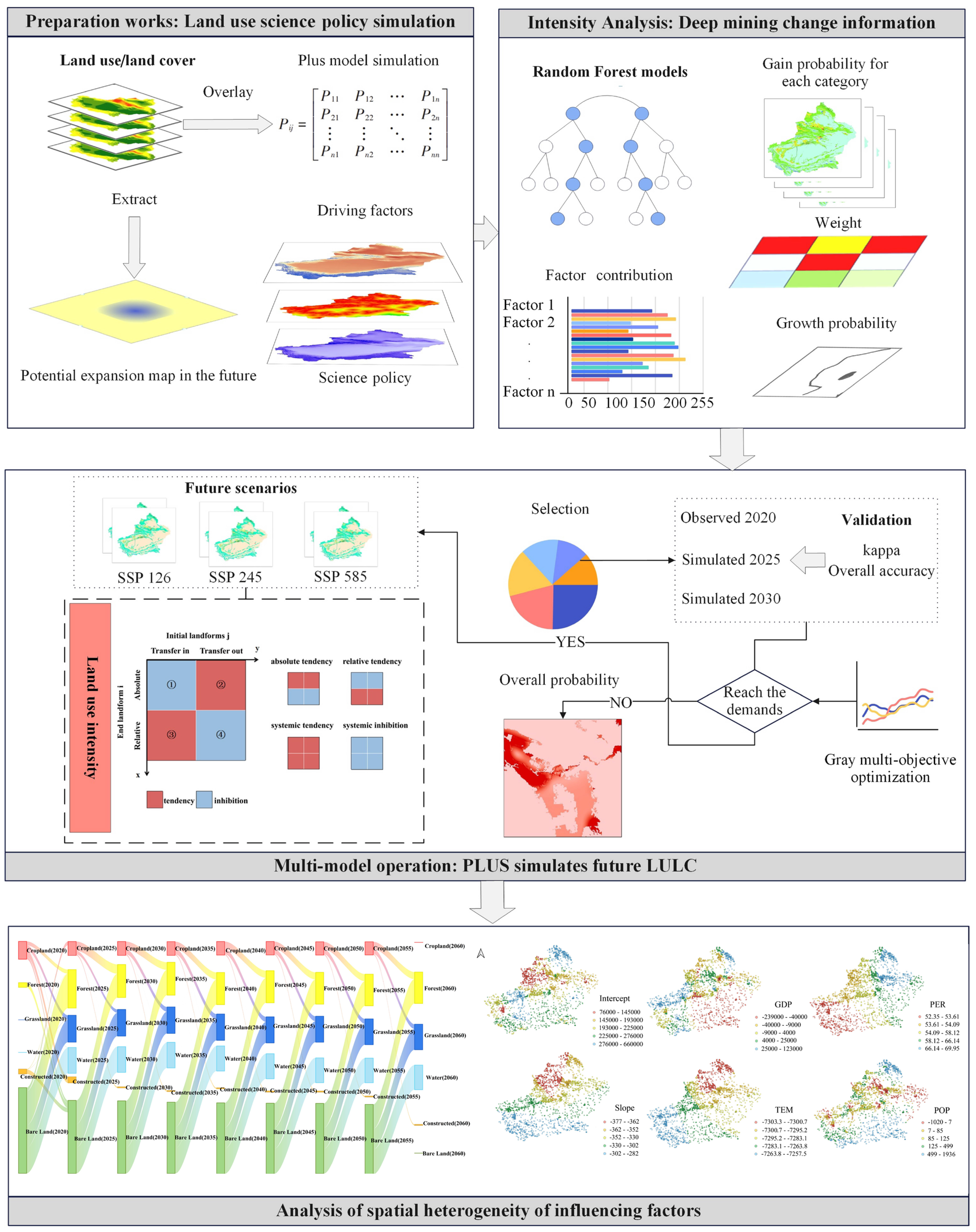
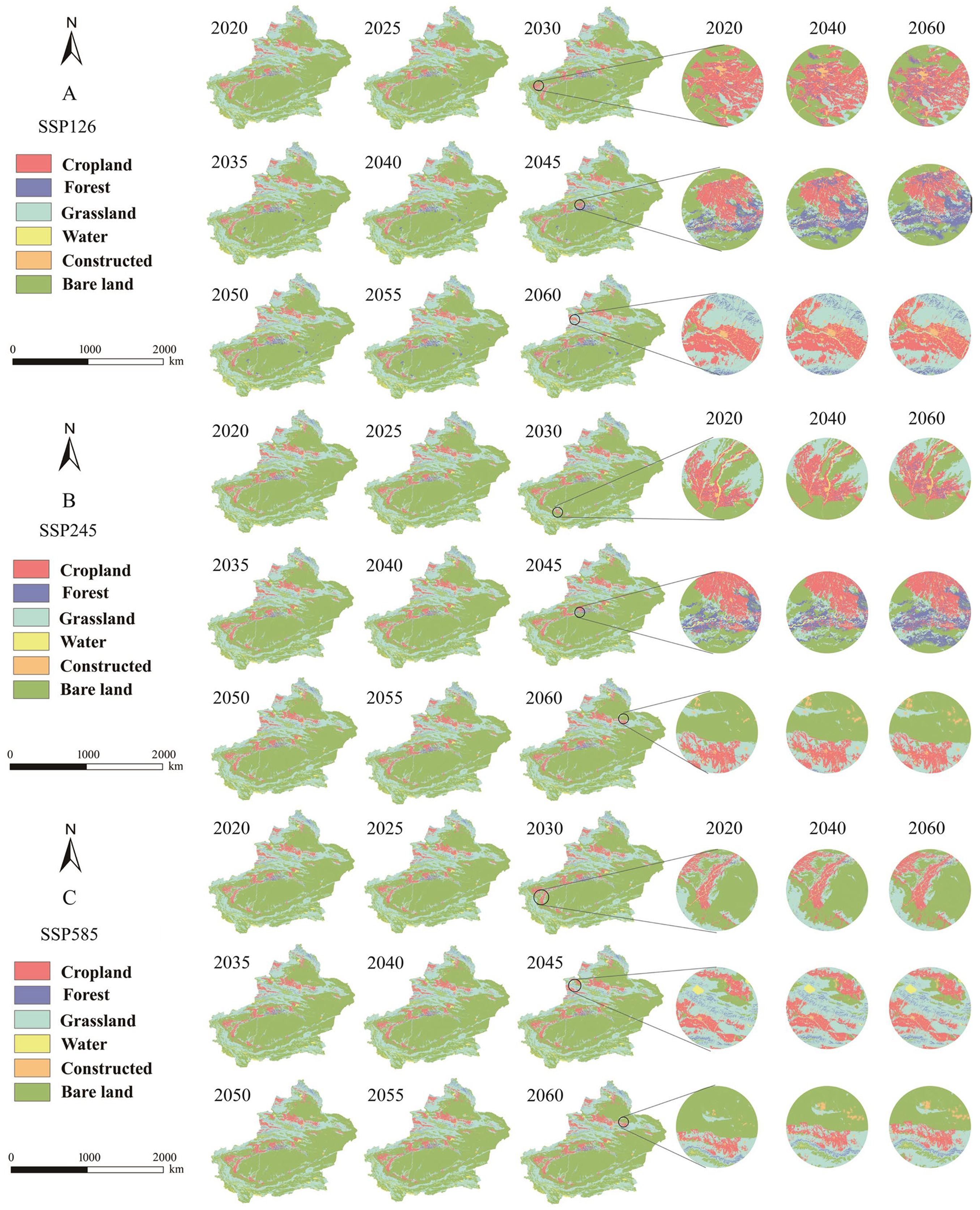

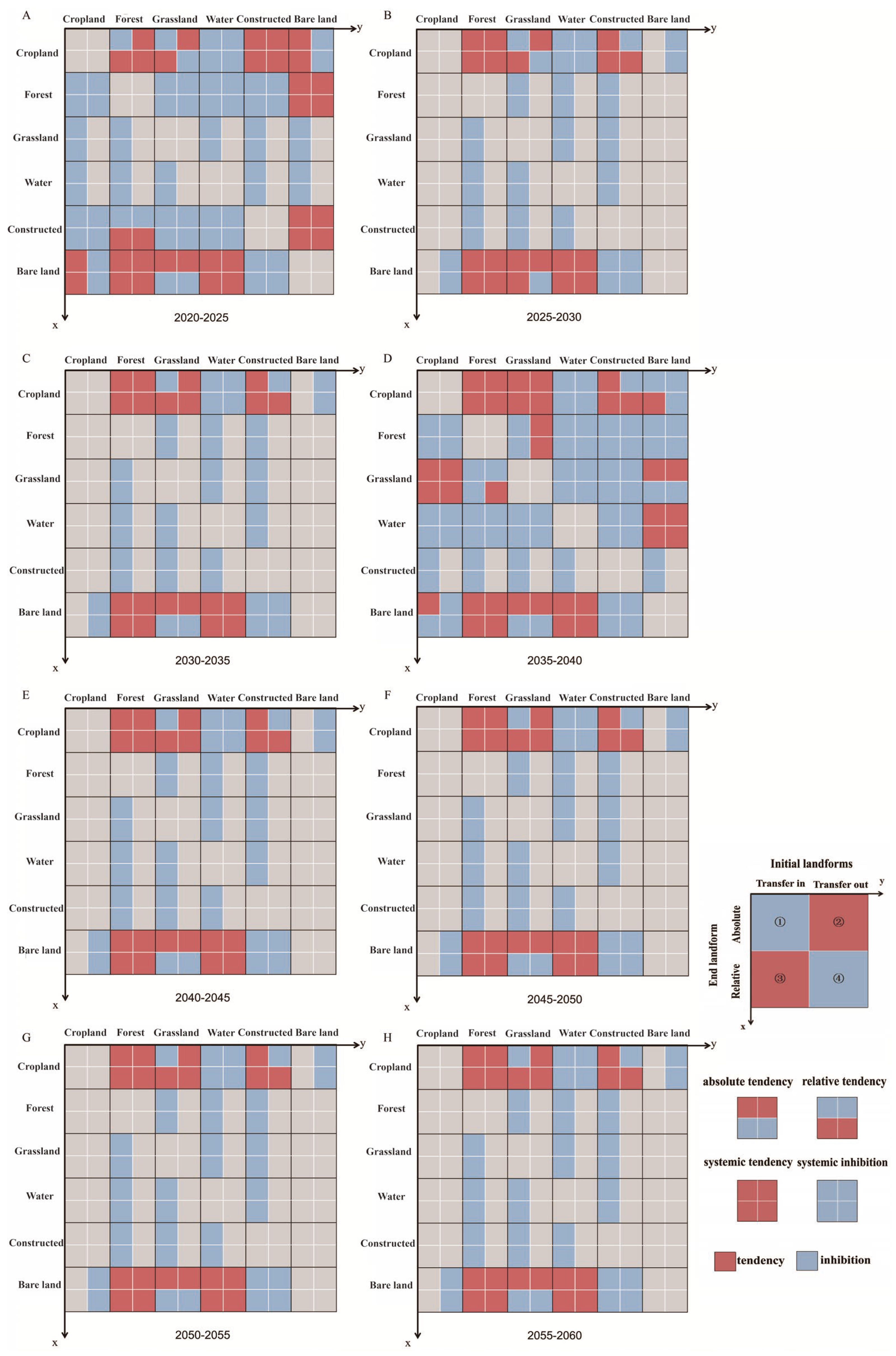

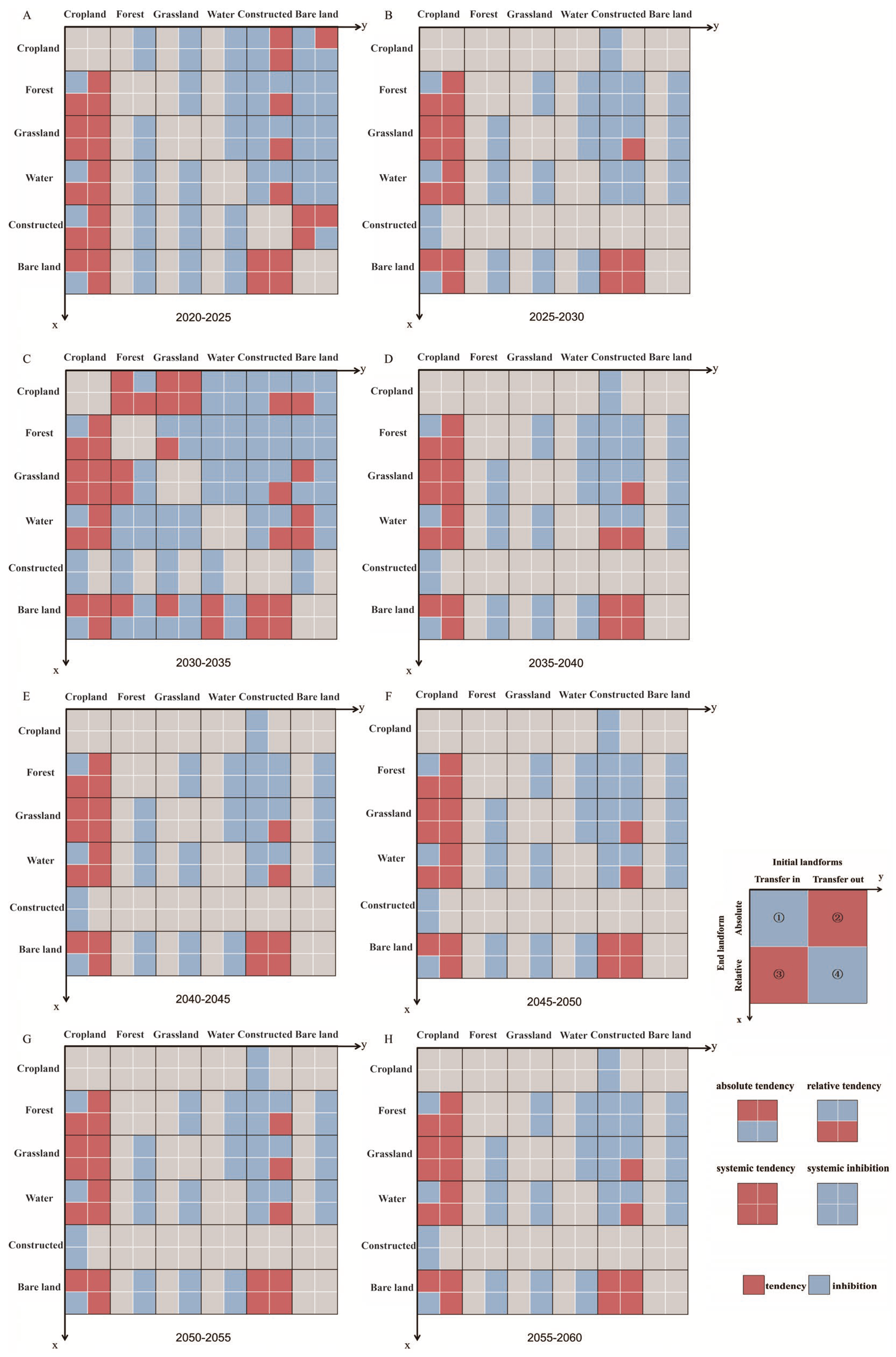


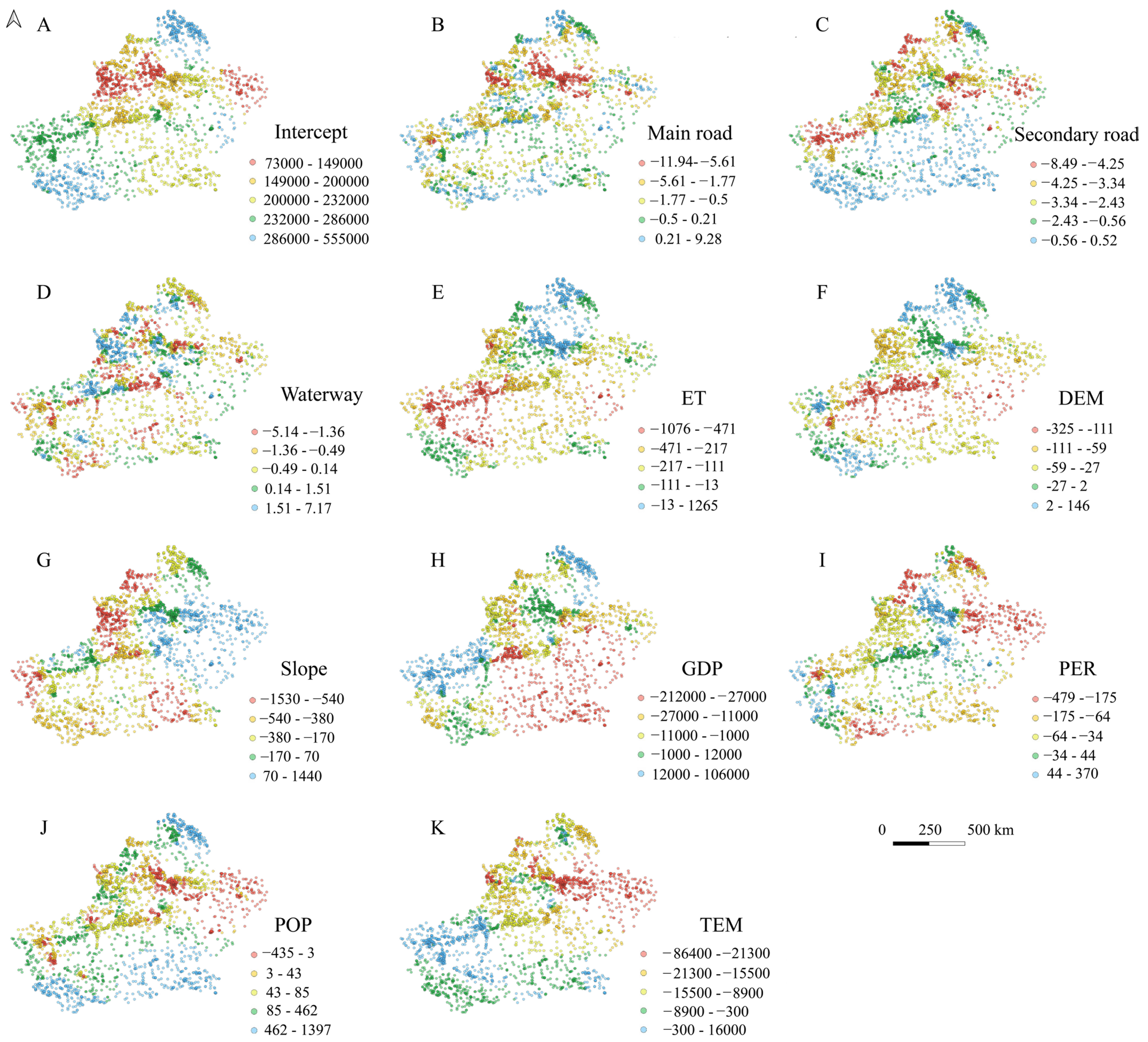

| Data | Sub-Data | Sources |
|---|---|---|
| Land use data | Land use | Resource and Environment Science Data Center, Chinese Academy of Sciences http://www.resdc.cn/ |
| Natural data | DEM | Geospatial data clouds http://www.gscloud.cn/ |
| Slope | Geospatial data clouds http://www.gscloud.cn/ | |
| Soil type | Food and Agriculture Organization of the United Nations https://www.fao.org | |
| Evapotranspiration data | https://figshare.com/ | |
| Vector data for river systems | National Catalog Service For Geographic Information http://www.webmap.cn | |
| Future climate data | Coupled Model Intercomparison Project Phase 6 https://esgf-data.dkrz.de | |
| Socioeconomic data | Future population density data | https://figshare.com |
| Future GDP data | https://figshare.com | |
| Vector dataset of major roads, minor roads | Open Street Map https://www.openstreetmap.org |
Disclaimer/Publisher’s Note: The statements, opinions and data contained in all publications are solely those of the individual author(s) and contributor(s) and not of MDPI and/or the editor(s). MDPI and/or the editor(s) disclaim responsibility for any injury to people or property resulting from any ideas, methods, instructions or products referred to in the content. |
© 2025 by the authors. Licensee MDPI, Basel, Switzerland. This article is an open access article distributed under the terms and conditions of the Creative Commons Attribution (CC BY) license (https://creativecommons.org/licenses/by/4.0/).
Share and Cite
Huang, L.; Wu, H.; Shi, M.; Tian, J.; Zheng, K.; Dong, T.; Wang, S.; Li, Y.; Li, Y. Characteristics of Changes in Land Use Intensity in Xinjiang Under Different Future Climate Change Scenarios. Sustainability 2025, 17, 4322. https://doi.org/10.3390/su17104322
Huang L, Wu H, Shi M, Tian J, Zheng K, Dong T, Wang S, Li Y, Li Y. Characteristics of Changes in Land Use Intensity in Xinjiang Under Different Future Climate Change Scenarios. Sustainability. 2025; 17(10):4322. https://doi.org/10.3390/su17104322
Chicago/Turabian StyleHuang, Lijie, Hongqi Wu, Mingjie Shi, Jingjing Tian, Kai Zheng, Tong Dong, Shanshan Wang, Yunhao Li, and Yuwei Li. 2025. "Characteristics of Changes in Land Use Intensity in Xinjiang Under Different Future Climate Change Scenarios" Sustainability 17, no. 10: 4322. https://doi.org/10.3390/su17104322
APA StyleHuang, L., Wu, H., Shi, M., Tian, J., Zheng, K., Dong, T., Wang, S., Li, Y., & Li, Y. (2025). Characteristics of Changes in Land Use Intensity in Xinjiang Under Different Future Climate Change Scenarios. Sustainability, 17(10), 4322. https://doi.org/10.3390/su17104322







